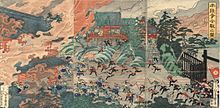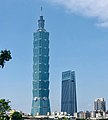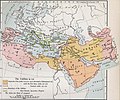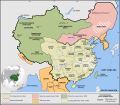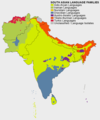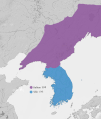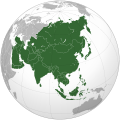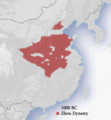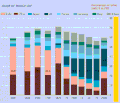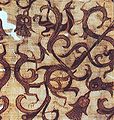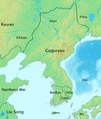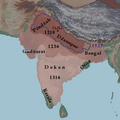Portal:Asia

 Asia (/ˈeɪʒə/ ⓘ AY-zhə, UK also /ˈeɪʃə/ AY-shə) is the largest continent in the world by both land area and population. It covers an area of more than 44 million square kilometres, about 30% of Earth's total land area and 8% of Earth's total surface area. The continent, which has long been home to the majority of the human population, was the site of many of the first civilisations. Its 4.7 billion people constitute roughly 60% of the world's population. Asia shares the landmass of Eurasia with Europe, and of Afro-Eurasia with both Europe and Africa. In general terms, it is bounded on the east by the Pacific Ocean, on the south by the Indian Ocean, and on the north by the Arctic Ocean. The border of Asia with Europe is a historical and cultural construct, as there is no clear physical and geographical separation between them. A commonly accepted division places Asia to the east of the Suez Canal separating it from Africa; and to the east of the Turkish straits, the Ural Mountains and Ural River, and to the south of the Caucasus Mountains and the Caspian and Black seas, separating it from Europe. Since the concept of Asia derives from the term for the eastern region from a European perspective, Asia is the remaining vast area of Eurasia minus Europe. Therefore, Asia is a region where various independent cultures coexist rather than sharing a single culture, and the boundary between Europe is somewhat arbitrary and has moved since its first conception in classical antiquity. The division of Eurasia into two continents reflects East–West cultural differences, some of which vary on a spectrum. (Full article...) Featured articleThe Boshin War (戊辰戦争, Boshin Sensō), sometimes known as the Japanese Revolution or Japanese Civil War, was a civil war in Japan fought from 1868 to 1869 between forces of the ruling Tokugawa shogunate and a coalition seeking to seize political power in the name of the Imperial Court. The war stemmed from dissatisfaction among many nobles and young samurai with the shogunate's handling of foreigners following the opening of Japan during the prior decade. Increasing Western influence in the economy led to a decline similar to that of other Asian countries at the time. An alliance of western samurai, particularly the domains of Chōshū, Satsuma, and Tosa, and court officials secured control of the Imperial Court and influenced the young Emperor Meiji. Tokugawa Yoshinobu, the sitting shōgun, realizing the futility of his situation, abdicated and handed over political power to the emperor. Yoshinobu had hoped that by doing this the House of Tokugawa could be preserved and participate in the future government. (Full article...) Selected Country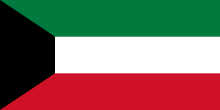 Kuwait, officially the State of Kuwait, is a country in West Asia and the geopolitical region known as the Middle East. It is situated in the northern edge of the Arabian Peninsula at the tip of the Persian Gulf, bordering Iraq to the north and Saudi Arabia to the south. With a coastline of approximately 500 km (311 mi), Kuwait also shares a maritime border with Iran, across the Persian Gulf. Most of the country's population reside in the urban agglomeration of Kuwait City, the capital and largest city. As of 2024[update], Kuwait has a population of 4.82 million, of which 1.53 million are Kuwaiti citizens while the remaining 3.29 million are foreign nationals from over 100 countries. Kuwait has the third largest foreign-born population in the world. Before the discovery of oil reserves in 1938, the country was a regional trade port; from 1946 to 1982, the country underwent large-scale modernization, largely based on income from oil production. In the 1980s, Kuwait experienced a period of geopolitical instability and an economic crisis following the stock market crash. In 1990, Kuwait was invaded and subsequently annexed by Iraq under the leadership of Saddam Hussein following disputes over oil production. The Iraqi occupation of Kuwait ended on 26 February 1991, after an American-led international coalition expelled Iraqi forces from the country during the Gulf War. (Full article...) Featured biographyUnas /ˈjuːnəs/ or Wenis, also spelled Unis (Ancient Egyptian: wnjs, hellenized form Oenas /ˈiːnəs/ or Onnos), was a pharaoh, the ninth and last ruler of the Fifth Dynasty of Egypt during the Old Kingdom. Unas reigned for 15 to 30 years in the mid-24th century BC (circa 2345–2315 BC), succeeding Djedkare Isesi, who might have been his father. Little is known of Unas' activities during his reign, which was a time of economic decline. Egypt maintained trade relations with the Levantine coast and Nubia, and military action may have taken place in southern Canaan. The growth and decentralization of the administration in conjunction with the lessening of the king's power continued under Unas, ultimately contributing to the collapse of the Old Kingdom some 200 years later. (Full article...) General imagesThe following are images from various Asia-related articles on Wikipedia. Featured pictureThe earliest credible evidence of either coffee drinking or knowledge of the coffee tree appears in the late 15th century, by Sufi Imam Muhammad Ibn Said Al Dhabhani who is known to have imported goods from Ethiopia to Yemen. From the Arabian peninsula its use spread across the globe. The picture shows Palestinian women grinding coffee beans.
Did you know...
Updated: 6:33, 14 February 2024 In the news
Related portalsMajor Religions in Asia Middle East Central Asia and Caucasus Indian Subcontinent Southeast Asia East Asia Selected panorama
The Ratchaprasong and Sukhumvit skylines of Bangkok, the capital of and largest city in Thailand, with Lumphini Park in the center, as viewed from the Sathon District. Known in Thai as Krung Thep ("city of angels"), it became the capital in 1768 after the destruction of Ayutthaya by Burmese invaders. TopicsCategoriesAssociated WikimediaThe following Wikimedia Foundation sister projects provide more on this subject:
More portalsShortcuts to this page: Asia portal • P:ASIA |

